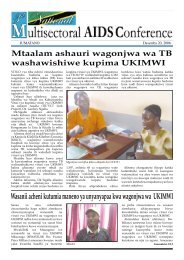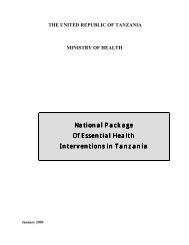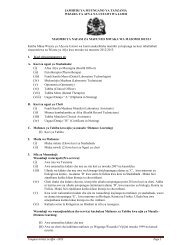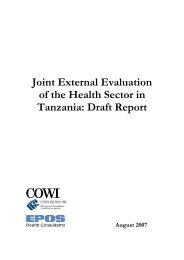Environmental and Social Management Framework for Tanzania ...
Environmental and Social Management Framework for Tanzania ...
Environmental and Social Management Framework for Tanzania ...
You also want an ePaper? Increase the reach of your titles
YUMPU automatically turns print PDFs into web optimized ePapers that Google loves.
3.1.3 Categorization of Impacts<br />
To facilitate identification <strong>and</strong> assessment of impacts, typical project activities, to be<br />
implemented under the laboratory construction <strong>and</strong> upgrading of the Regional Health<br />
Systems Strengthening <strong>and</strong> TB Support Project were broadly categorized into the<br />
following project phases:<br />
planning <strong>and</strong> design;<br />
construction <strong>and</strong> rehabilitation;<br />
operation <strong>and</strong> maintenance <strong>and</strong>.<br />
decommissioning <strong>and</strong> closure.<br />
Activities in each of the project phases listed above will have environmental <strong>and</strong><br />
social consequences on the different environmental components such as l<strong>and</strong>scape,<br />
soils, vegetation, water resources, air quality, ecosystems, <strong>and</strong> the socio-economy.<br />
Table 3.1 relates the four project phases to the environmental components.<br />
3.2 ASSESSMENT OF IMPACTS<br />
3.2.1 Generic Positive Impacts<br />
Most of the impacts of the Regional Health Systems Strengthening <strong>and</strong> TB Support<br />
Project will be positive <strong>and</strong> will generally impact on the socioeconomic component at<br />
the global, regional <strong>and</strong> national level. The participating regional countries will benefit<br />
from direct positive impacts in the areas of improved health <strong>and</strong> the associated<br />
socio-economic development. Key positive impacts of the project will be major <strong>and</strong><br />
long term <strong>and</strong> will include the following:<br />
1. Improvement of Health in Participating Countries<br />
The project will contribute to improvement of health in participating countries<br />
through increase in provision of <strong>and</strong> access to improved health care <strong>and</strong><br />
laboratory services to patients.<br />
2. Contribution to Global <strong>and</strong> Regional Health Objectives<br />
The project will contribute to the achievement of the Millennium Development<br />
Goal Number 6 (Combating HIV <strong>and</strong> AIDS, malaria <strong>and</strong> other diseases), <strong>and</strong><br />
more specifically to the global targets to “reduce the prevalence <strong>and</strong> death rates<br />
associated with TB” <strong>and</strong> to increase the “proportion of TB cases detected <strong>and</strong><br />
cured”.<br />
3. Increase in TB Case Detection <strong>and</strong> Treatment Success Rates<br />
Improving the accuracy <strong>and</strong> turnaround time of TB diagnostic techniques will<br />
contribute to increase in case detection <strong>and</strong> treatment success rates, as TB<br />
infectious individuals will be placed on correct treatment in the early stages.<br />
4. Complementing other TB Programmes<br />
By focusing on diagnostic capacities, the project will complement initiatives of<br />
other donors financing scale-up of TB treatment, including improved access to<br />
MDR-TB treatment. Combination of these ef<strong>for</strong>ts will contribute to the overall<br />
reduction in TB burden <strong>and</strong> transmission rates.<br />
24







